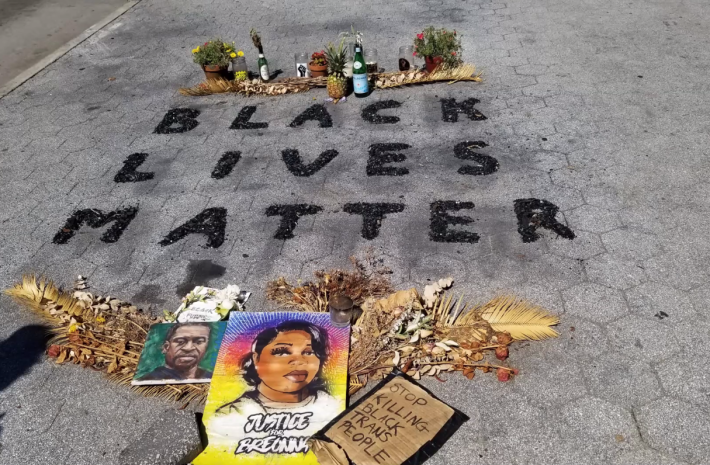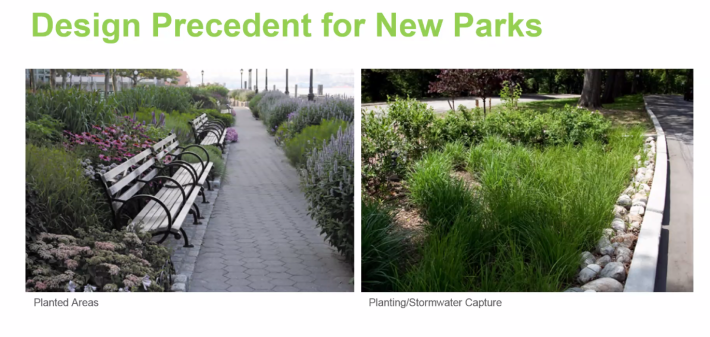Note: GJEL Accident Attorneys regularly sponsors coverage on Streetsblog San Francisco and Streetsblog California. Unless noted in the story, GJEL Accident Attorneys is not consulted for the content or editorial direction of the sponsored content.
Achieving "equity," when it comes to parks, can't just mean everyone lives within a ten-minute walk from a park--not when the chunk of fenced-in, cracked asphalt of the lead image counts as one, explained Mitchell Silver, the commissioner of the New York City Department of Parks and Recreation, in Monday's keynote address from SPUR's Idea + Action Conference. The conference hopes to look at all aspects of city development and the urban realm in the time of COVID and the Black Lives Matter movement. But first urban planners have to ask a basic question, said Silver: "Are we fair about how we share resources and how we invest in our cities and places? In most places the answer is 'no.'"
Silver, who oversees the management, planning, and operations of nearly 30,000 acres of public space across the five boroughs of New York City, including parks, playgrounds, beaches, marinas, recreation centers, wilderness areas, and other assets, found this out when he attempted to fulfill a challenge issued by his city's mayor. "NYC spent $5.7 billion over two decades to try and improve parks. The goal was that every New Yorker should live within a ten-minute walk to a park. Now it's 81.5 percent."
That goal sounds worthwhile and familiar, because San Francisco has boasted about achieving this same objective. But Silver wants planners to remember it's not just about proximity; it's about quality. And that means planners have to get out into the community, always.

As Silver points out, Lafayette Playground in Brooklyn counted as a park when he came into office. So did many other parks, disproportionately in Black and Brown communities, that were surrounded by high fences, full of restrictive signs, and completely uninviting. "I wouldn’t let my child or grandchild into that park," said Silver of many of the parks he saw.
He added that in this context, a better word for "equity" is just plain fairness.
"Is it a park, or a parking lot," he said of Lafayette Playground, pictured above. "That is not fair. That is not a quality public space."
Many parks in New York seemed designed to intentionally make people feel unwelcome. Silver told his staff to remove all signs banning loitering. "If you see couples enjoying themselves," we say that's fine, he explained. "But if I see five Black teenagers on a park bench? 'Loiter' means to stand around without an apparent purpose. But it’s a park! We use the word loitering when we don’t like the person who is there."

The solution, Silver pointed out, is to connect with the different communities around parks and provide for and welcome differing uses. "I don’t believe in outreach. I believe in engagement. I need to spend time in the community," he explained. "We have translators, make sure it’s in the evening.
Silver recalls the engagement they conducted to rebuild the parks pictured above. They worked with the Asian community to bring them out to meetings. At first, some in the audience had an aversion to including basketball courts in the rebuilt park. But he said a young Black man at the meeting had seen it was important to have a plaza for Tai Chi for the Asian community and he asked that the city provide it. The Asians in the room welcomed the idea, and then reciprocated by warming to the idea of having basketball courts. By looking after the interests of multiple age groups and multiple cultures, it became possible to build an inclusive park. "It was a magical moment where diverse perspectives were brought together to produce different outcomes."
Silver cited this park in downtown Detroit as a prime example of how to make all groups feel welcome:

It's colorful. It's got lots of places to sit and lots of plants. And it's inclusive. "Detroit had the audacity to put a basketball court in the center of their city," he said. "It said to Black youth: you matter!"
He added that parks should also be used to celebrate cultural heritage and pay homage to the injustices of the past--and present. He said that the Black Lives Matter movement has had a huge impact on parks in New York and he wanted that to continue in public, civic space. "I told staff to leave informal memorials [alone]," he said, remarking that normally clean up crews would remove such memorials.

"Respect how people feel. People want to feel free to express themselves in public spaces."
Of course, building good parks also means attention to planting trees and greenery. But he said parks shouldn't really end at the park entrance. "Provide open sight-lines, remove gates," he said. "We want to improve views into the park and rethink the sidewalk as the outer park."


There's no reason, he said, that a park treatment should abruptly end at the border of the park--as seen in the above images, lowering fences and adding benches and other treatments to the sidewalk can help make the entire city feel like it is part of an inviting public realm.
And don't stop there. Streets too can become part of public space, instead of just areas for cars. "Convert under-performing asphalt with paint, chairs, and flowerpots to make dynamic public spaces," he said.

He added that most people don't know--or care--if they're on parks department land, DOT land (meaning streets), or a sidewalk. They just want welcoming public spaces for the whole community to enjoy.
For more events like these and a full rundown of the Idea + Action Conference, visit SPUR’s events page.





